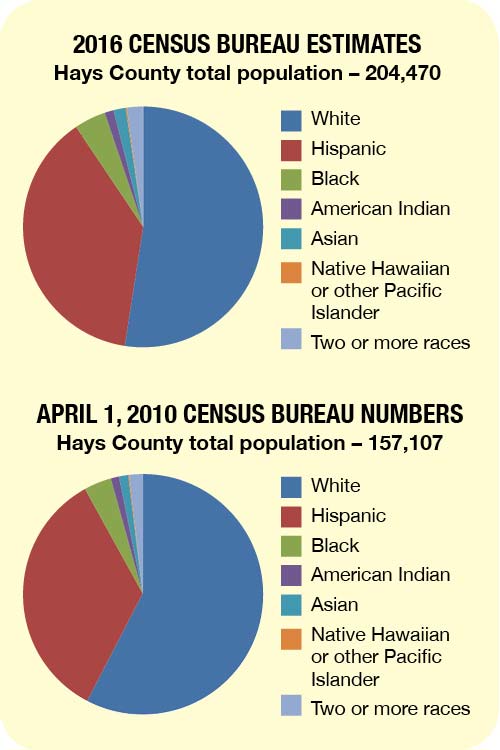Hays Free Press
BY MOSES LEOS III ON JUNE 28, 2019
Nearly 80,000 people made up the Hispanic population in Hays County in 2016, which constituted a 41 percent rise since the 2010 Census.
That figure, part of newly released Census Bureau estimates, followed the trend of a rapidly growing Hispanic population in Texas and the United States.
Pauline Anton, President and CEO of the Texas Association of Mexican American Chambers of Commerce (TAMACC) in Buda, says the numbers show what many in the community have known for some time.
 “We’ve been saying this (increase is coming). Now that the new Census data is out, it shows the huge population burst,” Anton said. “It’s here in Texas and it’s huge in Texas, and always has been.”
“We’ve been saying this (increase is coming). Now that the new Census data is out, it shows the huge population burst,” Anton said. “It’s here in Texas and it’s huge in Texas, and always has been.”
Growth in the Hispanic population is reaching into communities, such as Hays County, that “may not had as much diversity” in the past, Anton said.
The state’s proximity to Mexico is one factor that’s led to the rapid rise in the population.
As a result, business growth in the population is also on the rise. Anton said the Hispanic population is the fastest growing when it comes to entrepreneurship.
In Texas, Anton said there are more than 700,000 business owned by a Hispanic person. Businesses range from landscaping to restaurateurs, as well as doctors, certified public accountants (CPAs) and attorneys.
“It’s putting people to work. That is driving the population growth here,” Anton said. “If there’re jobs, people will come. If there’re no jobs, they will look elsewhere.”
Many segments of society are also starting to take notice of the Hispanic population increase. Anton said corporations recognize Hispanics and Latinos are a growing consumer base.
Corporations also realize many Hispanics and Latinos are also loyal to sponsors and brands, and that loyalty is passed down through generations, Anton said.
But amid the successes and the rising population, Hispanics still face a variety of challenges. According to Anton, starting up a business is more challenging for Hispanics than it was 10 to 15 years ago.
“The Hispanic business owners, they have an entrepreneurial spirit that’s like no other,” Anton said. “They create business to be able to provide for families, not only for their families and future generations.”
Struggles in representation continue for those in the Hispanic community. While larger cities such as Austin, Dallas and San Antonio harbor a diverse city council, smaller communities may not represent the overall Hispanic population as much.
For example, only five of the 21 total elected officials on the Kyle and Buda City Councils and Hays CISD school board are Hispanic. There are no Hispanic individuals on the Wimberley or Dripping Springs City Councils. Michael Torres is the only Hispanic constable in Hays County, while Debbie Gonzales Ingalsbe is the only Hispanic Hays County Commissioner.
Serving on a school board is still a new concept in Hispanic families. Often times, Hispanic entrepreneurs are operating their businesses and providing for their families and don’t have the time to volunteer for these positions.
“It hasn’t really been pushed in the community,” Anton said. “Now it is, because the community recognizes the importance of Hispanic representatives and elected officials.”
Anton said it’s important for leaders and businesses to look at the demographics and “embrace” that the Hispanic population will become the majority population in the near future.
“Instead of fighting or ignoring, let’s start embracing our neighbors and figure out how to work together,” Anton said.





















